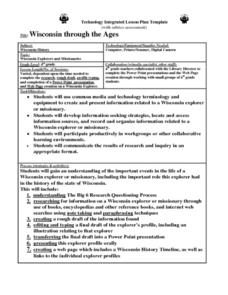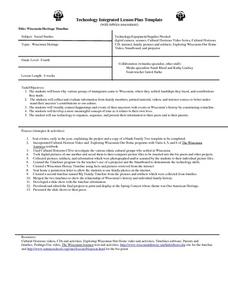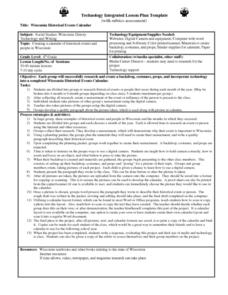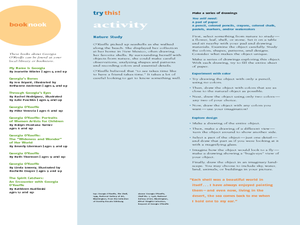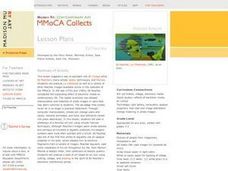Curated OER
Wisconsin
In this Wisconsin state history instructional activity, 4th graders read two pages of information about Wisconsin then complete 10 true and false questions.
Education World
Every Day Edit - Wisconsin
In this everyday editing learning exercise, students correct grammatical mistakes in a short paragraph about Wisconsin. The errors range from punctuation, capitalization, spelling, and grammar.
Curated OER
Investigating Immigration and Settlement in Wisconsin
Fourth graders identify the origins of their own ancestors and possible reasons for immigration. They research immigrant groups of Wisconsin, including origins and daily life, and then create timelines depicting their settlements.
Scholastic
Perfect Postcards: Illinois
Connect the geography and history of Illinois using an art-centered lesson on the railroads. The railroad connected once-distant places, particularly in the Midwest. Using research, class members create postcards of fictional cross-state...
Curated OER
Windows of Wisconsin (History)
Fourth graders research the history of Wisconsin. They explore Wisconsin's culture, sovereignty and environment. Using multiple computer technology resources (computer, scanner, camera, internet), 4th graders develop a book on the...
Curated OER
Wisconsin Through the Ages
Fourth graders research Wisconsin explorers. They analyze sources for information related to a Wisconsin explorer or missionary. They create a rough draft and edit and type a final draft including a profile of their explorer and...
Curated OER
Wisconsin Heritage Timeline
Fourth graders explore why groups of immigrants settled in Wisconsin. Through intervies with family members, printed materials, and internet research, 4th graders discover the contributions early residents made to the state. Students...
Curated OER
Wisconsin Historical Events Calendar
Fourth graders create a calendar of historical events and people in Wisconsin. They select a month of the year and research events and people using the Internet and other resources. They collect their research and create a reencactment...
Curated OER
Mammals of Wisconsin
Students explore the exciting world of mammals as they learn the identities of some Wisconsin native residents. They examine their adaptations and learn how they survive in a state with a wide array of temperatures and ecosystems.
Curated OER
Black Hawk Island Hike
Students explore Wisconsin's natural and cultural history through hands-on exploration of Upham Woods. They are shown the basic paddling skills and they work in teams to paddle across the river on barge. Students describe cultural...
Curated OER
The Beautiful Works of Georgia O'Keefe
Learners discover the art of Georgia O'Keefe. In this art history lesson plan, students investigate the influential power nature has on art. Learners create their own works of art by observing local nature.
Curated OER
Pre-Colonial Native American Groups
Students investigate U.S. history by researching the Internet and taking a test. In this American Indian group lesson plan, students identify the many specific Native American tribes and their geographic locations. Students research the...
Curated OER
Cashton Community Quilters
Fourth graders create and construct a fabric quilt symbolizing the heritage of the Wisconsin community of Cashton. They research Wisconsin historical symbols and use math skills to calculate the number and sizes of the quilt squares. ...
Curated OER
Dell House Dig
Young scholars demonstrate basic procedures for archeological excavations. They participate in an archaeological dig exploration off of Blackhawk Island in the Wisconsin River where the Dell House once stood.
Curated OER
The First Earth Day
In this Earth Day worksheet, students read about the history of the first Earth Day and answer short answer questions about it. Students complete 8 questions total.
Curated OER
Wisconsin History and Information
Fourth graders complete a multi-faceted project about the people, places, and government of Wisconsin. Working with traditional and technological resources, they research various topics related to the history of Wisconsin and create a...
Curated OER
Prehistoric Indians
Fourth graders identify the four Native American groups of Wisconsin. They compare the four groups through discussion and list the four groups with their tools, food, shelter, and time period.
Curated OER
Corn: An A-maizing Plant
Students explore the corn crop. In this farming instructional activity, students identify which states are in the corn belt and read about the history of corn, its uses and its development and growth. Students dissect a corn kernel....
Curated OER
Faces, Places, and Traces of Wisconsin
Fourth graders view a teacher-created PowerPoint presentation. They read and conduct research, taking notes as they go. Students build a storyboard of their projected slide show. They create a PowerPoint show based on their storyboard....
Curated OER
Jewel of the Mississippi Delta
Students develop their own website to show the information they gathered about the Mound Bayou on the Mississippi Delta. After taking a field trip to the area, they create their own coloring books, stories and games to share the history...
Curated OER
Hunt for Habitats
Students review components of a habitat and go on a hike around a pond and woods exploring different habitats and the plants and animals that use them. They examine mammal pelts and discuss the life histories, adaptations, and positions...
Curated OER
Ed Paschke
Students examine and discuss the artistic style and techniques of the artist Ed Paschke. They analyze various works of art by Ed Paschke, then choose an icon from art history and alter a photocopy of it using scissors and collage materials.
Curated OER
To Protect and Preserve
Learners discuss the impact of war on the Iraqi National Museum and the importance of protecting artifacts of cultural heritage. They write letters to the Milwaukee Public Museum to show support for funding for the protection of the...
Curated OER
What's Missing?
Students examine their beliefs about archaeological preservation. They articulate a response to archaeological resource destruction. Students then complete two puzzles and relate them to archaeological research.







